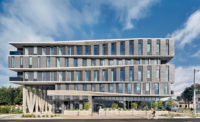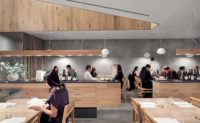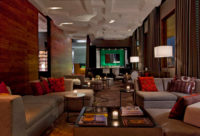Although Burton Baldridge, 48, entered the profession later than some, he has made up for lost time since founding his eponymous firm less than 10 years ago. Following law school at the University of Texas in Austin, and a four-year stint as a commercial litigator in New York, Baldridge switched gears, graduating from Columbia University’s architecture program in 1999 and going to work for Peter Gluck. He moved to Austin in 2002 to serve as construction manager and on-site architect for Gluck’s ambitious Floating Box House, then stayed in the city after the project wrapped up, establishing his own shop in 2006.
A native Texan, Baldridge has spent roughly half his life in the capital city and witnessed its evolution over the years. He recoils at the idea that Austin has one singular identity. “We don’t embrace the faux narrative of an in-your-face, alt-country, hillbilly Frankenstein, Disney World version of Austin,” the architect says. Instead, the firm imbues designs with “an exuberant sense of sobriety”—treating each project’s site and program with a quiet reverence.
The 10-person office splits its time among residential, commercial, and institutional projects, with frequent forays into adaptive reuse. A focus on tailoring spaces to experiences and interactions drives Baldridge’s work. “We make sure there’s complete simpatico between what the client needs and what would improve the site to really take a project to the next level.”
Designs for ground-up commercial projects, like the forthcoming Hotel Rainey in Austin, consider the adjacent public spaces in order to integrate seamlessly with the existing and future environment. For the boutique hotel, the architect is working with the city to reimagine the service alley behind the building as a public street and to provide a secondary entrance. “It has unwittingly become a much larger and cooler project,” he says, “because now we’re talking about place-making.”
This attention to context is also apparent in the firm’s adaptive-reuse work. Baldridge Architects’ own office (a concrete-masonry building that was formerly a warehouse for a TV repair business) and the post office-cum-restaurant Gardner (architectural record, September 2015) retain details from the original structures but reinterpret them in new ways.
When the 2008 recession hit, small public jobs sustained the young firm—both creatively and practically. “We were faced with the problem of trying to carve out our identity and convey our ambitions in an environment where there wasn’t any money,” he says. “But you can do pro bono work no matter how bad the economy, since the mission of those projects is to lose money,” he jokes.
Lean days now past, the firm continues to pursue pro bono and public projects, including an open-air classroom for Casis Elementary School in 2012 and the temporary 2014 light installation Tracing the Line for the Waller Creek Conservancy. “We chase these small public projects,” Baldridge says. “They’re a chance to do more speculative work and are good exercises in getting the team to loosen up and see possibilities we could employ in larger projects.”
Today, Baldridge says it’s a great time to be an architect in Austin. “I’ve found myself turning down projects that five years ago I’d have gnawed off my arm to take.” With out-of-town jobs in the pipeline, such as a desert-modern residence in the Texas Hill Country town of Fredericksburg, and plenty on its plate in Austin, the office finds itself pushed and pulled in new ways. “There’s a constant tension between our desire that everything be thoroughly detailed and considered, but also not letting that hold back the more ambitious thinking on the projects,” says the firm’s founder. “Overall, it’s the cohesiveness of the idea that always matters the most.”
Baldridge Architects
FOUNDED: 2006
DESIGN STAFF: 10
PRINCIPAL: Burton Baldridge
EDUCATION: Columbia GSAP, M.Arch., 1999; University of Texas School of Law, J.D., 1993; University of Texas, B.A. & B.B.A., 1990
WORK HISTORY: Peter Gluck and Partners Architects, 2001–05; a+i design corp., 2000–01; Deamer & Phillips, 1998–2000
KEY COMPLETED PROJECTS: Gardner Restaurant, 2014; Waller Creek, 2014; Baldridge Architects’ offices, 2013; Casis Elementary Outdoor Learning Center, 2012; Stubb’s Greenroom, 2011; Deep Eddy Residence, 2010; Avenue G Studio, 2009; Kimber Modern Hotel, 2009; Mohle House, 2006 (all in Austin, Texas)
Key Current PROJECTS: Branch House, Austin, 2016; High Road House, Travis County, 2016; Ledgecroft House, Fredericksburg, 2016; Hotel Rainey, Austin, 2017; Holy Cross Hall, St. Edward’s University, Austin, 2017; Arrive Hotel, Austin, 2017; Pinwheel House, Austin, 2018 (all in Texas)















Post a comment to this article
Report Abusive Comment